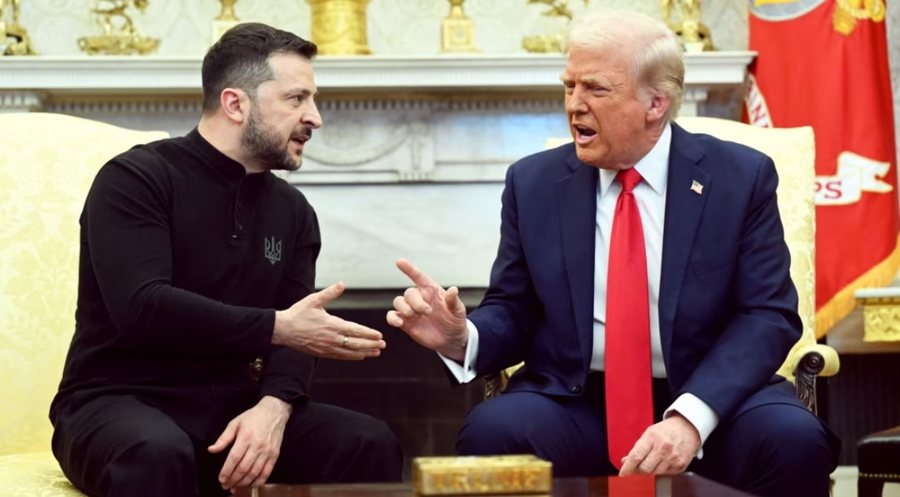
It could hardly get any worse.
Ukrainian President Volodymyr Zelensky's visit to the White House had a lot of potential.
It could have produced a mineral resources deal that would have united Ukraine and the United States – at least on paper – and would have made US President Donald Trump more inclined to support Kiev in its defense against Russian invasion.
It could also have brought some clarity about what kind of security guarantees - if any - Washington would be willing to offer Kiev, in the event of any ceasefire or peace agreement with Russia.
And, if nothing else, Zelensky and Trump could have eased their differences after exchanging criticism last week.
But tempers flared again - more than ever. Zelensky left the White House early after being reprimanded by Trump and Vice President JD Vance in the Oval Office.
The minerals agreement remained unsigned and the joint press conference was canceled.
The extraordinary exchange not only raised doubts about the fate of the natural resources pact. It also added to uncertainties about the future of American aid to Ukraine and the prospects for any agreement that would halt or end Russia's war in Ukraine.
The damage could be great.
The minerals deal that Trump and Zelensky were supposed to sign was only a framework agreement, and analysts assessed that at this point, its value would be largely symbolic: a chance for both presidents to claim diplomatic victories and a way for the Trump administration to justify its past and possibly future aid to Ukraine, after raising questions about whether it should continue or not.
Trump welcomed the draft agreement as an important step in what is seen as a difficult path to peace in Ukraine.
So, whenever it was signed, it would give Kiev and Washington a chance to work together on a possible ceasefire or peace agreement with Russia.
Beyond the minerals deal, the question now is whether the United States will turn its back on Ukraine, cutting off or limiting the military aid that is still ongoing, or continue its efforts to agree with Russia on a ceasefire or peace plan with Ukraine, but abandon Kiev.
The separation may last, or maybe not.
The tense meeting in the Oval Office was another low point in the difficult relationship between Trump and Zelensky, which has been turbulent since the latter's election as president in 2019.
But it may not be the end of the journey. It came just as it seemed that the damage caused by some previous criticisms - during which Trump called Zelensky a "dictator" and Zelensky said Trump was being swept up in the propaganda of Russian President Vladimir Putin - was being repaired.
Asked on the eve of Zelensky's visit about his description of himself as a "dictator," Trump replied: "Did I say that? I can't believe I said that."
For Zelensky, the desire to secure further U.S. aid and hopes for a security agreement backed by U.S. power are unlikely to fade, despite the difficult visit to the White House. So even after the dramatic meeting, there is a small chance that relations will improve.
The US-Europe rift could deepen
Ties between the United States and most of the European Union have been strained since Trump returned to office for a second term on January 20. The differences concern policies toward Ukraine and Russia, as well as a range of other issues - from trade to liberal values.
Tensions came to the fore when Vance criticized Europe during his speech at the Munich Security Conference on February 14, saying that its internal processes pose a greater threat to its well-being than Russia, China or any other external factor.
French President Emmanuel Macron and British Prime Minister Keir Starmer visited the White House this week in an attempt to bridge their differences, particularly on what to do about Russian aggression and the war in Ukraine.
If Zelensky's visit goes well, it could also bring greater unity between the US and Europe.
But the opposite could happen, especially after the disagreement in the Oval Office, which reignited transatlantic tensions, while many European leaders expressed solidarity with Ukraine.
Ukrainian President Volodymyr Zelensky delivers a speech during the 61st Munich Security Conference in Munich, Germany, February 15, 2025.
In a post on X in Ukrainian, European Commission President Ursula von der Leyen told Zelensky: "Be strong, be brave, be fearless" and assured him that he "will never be alone."
"We will continue to work with you for a just and lasting peace," von der Leyen said.
Blow to chances for "just peace"
When Zelensky and European leaders talk about “just and lasting peace,” they mean a peace that does not favor Russia and weakens Ukraine, leaving it under Moscow’s control or vulnerable to future Russian attacks.
When Trump called Putin on February 12 and sent senior officials to meet with their Russian counterparts in Riyadh six days later — thus reversing the efforts of his predecessor, Joe Biden’s administration, to isolate Moscow over its invasion of Ukraine — he raised fears in Kiev and Brussels that he was negotiating the wrong deal on Ukraine.
If the Zelensky-Trump meeting had gone well, it could have helped ease these concerns.
The Ukrainian president said it was important for Trump to meet with him before meeting with Putin.
But the meeting in the Oval Office did not go well at all, and these concerns are likely to rise again. (A2 Televizion)











